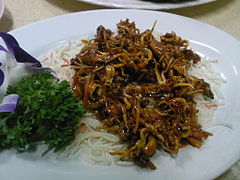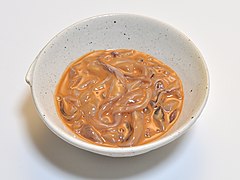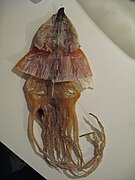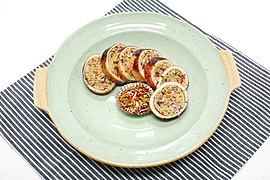Squid as food
Squid is eaten in many cuisines; in English, the culinary name calamari is often used for squid dishes.[1] There are many ways to prepare and cook squid. Fried squid is common in the Mediterranean. In New Zealand, Australia, the United States, Canada, and South Africa, it is sold in fish and chip shops, and steakhouses. In Britain, it can be found in Mediterranean 'calamari' or Asian 'salt and pepper fried squid' forms in various establishments, often served as a bar snack, street food, or starter.
"Calamari" redirects here. For other uses, see Calamari (disambiguation).Squid can be prepared for consumption in a number of other ways. In Korea and Japan, it is sometimes served raw, and elsewhere it is used as sushi, sashimi and tempura items, grilled, stuffed, covered in batter, stewed in gravy and served in stir-fries, rice, and noodle dishes. Dried shredded squid is a common snack in some Asian regions, including East Asia.
Etymology[edit]
The English name calamari comes from the Italian calamari (plural of calamaro), Spanish calamar, and Modern Greek καλαμάρι kalamári.[1] Ultimately, all of these terms derive from the Late Latin calamarium, "pen case" or "ink pot", itself from the Latin calamarius, "pertaining to a writing-reed", after the resemblance in shape and the inky fluid that squid secrete; calamarius in turn derives from the Greek κάλαμος kalamos 'reed' or 'pen'.[1][12][13][14][15][16]
Nutritional value[edit]
The nutritional value of squid compares favorably with fish, being high in protein and phosphorus with trace amounts of calcium, thiamine, and riboflavin.[17] Squid are 67.5–80.7% protein and 2.22–8.48% fat.[18] A 2016 study of loligo squid found that 13% of the wet weight was oil, which is a rich source of omega-3 and omega-6 fatty acids (2.78% arachidonic acid, 3.10% linolenic acid, 5.20% linoleic acid, 15.40% docosahexaenoic acid (DHA), and 9.60% eicosapentaenoic acid (EPA)).[19]
Allergies[edit]
Allergies to calamari can occur.[20] As with other molluscs, the allergen is probably tropomyosin.[21]









